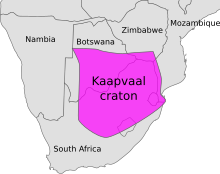The Ongeluk Large Igneous Province (Ongeluk LIP) is an early Paleoproterozoic large igneous province which resulted from the Ongeluk magmatic event, whose remnants are preserved on the Kaapvaal Craton, within its South African part. The Ongeluk LIP was defined in 2017 (Gumsley et al., 2017[1]). It consists of the Ongeluk Formation within the Griqualand West sub-basin of the Neoarchean to Paleoproterozoic Transvaal Supergroup and its feeders and an associated dolerite dyke swarm.[2]


Filamentous fossils dated to 2.4 Ga were found in basalt samples from the Ongeluk Formation, which were suggested to be fossils of fungi-like organisms.[3][4]
References edit
- ^ Gumsley, A.P., Chamberlain, K.R., Bleeker, W., Söderlund, U., de Kock, M.O., Larsson, E.R., Bekker, A., 2017, "Timing and tempo of the Great Oxidation Event", Proceedings of the National Academy of Sciences of the U.S.A., vol. 114, pp. 1811–1816.
- ^ Ashley Gumsley, March 2017 LIP of the Month. The Ongeluk LIP: a newly defined large igneous province on the critical Neoarchean-Paleoproterozoic boundary on the Kaapvaal Craton, southern Africa, Large Igneous Provinces Commission of the International Association of Volcanology and Chemistry of the Earth's Interior
- ^ Fungus-like mycelial fossils in 2.4-billion-year-old vesicular basalt, Nat Ecol Evol, 2017 Apr 24;1(6):141, PMID 28812648, doi:10.1038/s41559-017-0141 (full text)
- ^ Jerry Redfern, Earliest Fungus-Like Fossils Date Back 2.4 Billion Years, Live Science, April 24, 2017